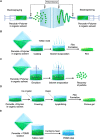Oxygen generating biomaterials at the forefront of regenerative medicine: advances in bone regeneration
- PMID: 38282892
- PMCID: PMC10811251
- DOI: 10.3389/fbioe.2024.1292171
Oxygen generating biomaterials at the forefront of regenerative medicine: advances in bone regeneration
Abstract
Globally, an annual count of more than two million bone transplants is conducted, with conventional treatments, including metallic implants and bone grafts, exhibiting certain limitations. In recent years, there have been significant advancements in the field of bone regeneration. Oxygen tension regulates cellular behavior, which in turn affects tissue regeneration through metabolic programming. Biomaterials with oxygen release capabilities enhance therapeutic effectiveness and reduce tissue damage from hypoxia. However, precise control over oxygen release is a significant technical challenge, despite its potential to support cellular viability and differentiation. The matrices often used to repair large-size bone defects do not supply enough oxygen to the stem cells being used in the regeneration process. Hypoxia-induced necrosis primarily occurs in the central regions of large matrices due to inadequate provision of oxygen and nutrients by the surrounding vasculature of the host tissues. Oxygen generating biomaterials (OGBs) are becoming increasingly significant in enhancing our capacity to facilitate the bone regeneration, thereby addressing the challenges posed by hypoxia or inadequate vascularization. Herein, we discussed the key role of oxygen in bone regeneration, various oxygen source materials and their mechanism of oxygen release, the fabrication techniques employed for oxygen-releasing matrices, and novel emerging approaches for oxygen delivery that hold promise for their potential application in the field of bone regeneration.
Keywords: bone defects; bone regeneration; controlled oxygen-releasing biomaterial; regenerative therapy; tissue engineering.
Copyright © 2024 Zhao, Zhou, Xiao, Zhang, Zhang, Xia, Jiang, Jiang, Ming, Zhang, Long and Liang.
Conflict of interest statement
The authors declare that the research was conducted in the absence of any commercial or financial relationships that could be construed as a potential conflict of interest.
Figures



Similar articles
-
Oxygen-Generating Biomaterials for Translational Bone Regenerative Engineering.ACS Appl Mater Interfaces. 2023 Mar 29. doi: 10.1021/acsami.2c20715. Online ahead of print. ACS Appl Mater Interfaces. 2023. PMID: 36988393 Review.
-
Oxygen-Releasing Biomaterials: Current Challenges and Future Applications.Trends Biotechnol. 2021 Nov;39(11):1144-1159. doi: 10.1016/j.tibtech.2021.01.007. Epub 2021 Feb 16. Trends Biotechnol. 2021. PMID: 33602609 Free PMC article. Review.
-
Hypoxia in Bone and Oxygen Releasing Biomaterials in Fracture Treatments Using Mesenchymal Stem Cell Therapy: A Review.Front Cell Dev Biol. 2021 Aug 20;9:634131. doi: 10.3389/fcell.2021.634131. eCollection 2021. Front Cell Dev Biol. 2021. PMID: 34490233 Free PMC article. Review.
-
Oxygen-releasing biomaterials for regenerative medicine.J Mater Chem B. 2023 Aug 9;11(31):7300-7320. doi: 10.1039/d3tb00670k. J Mater Chem B. 2023. PMID: 37427691 Review.
-
Oxygen-Generating Biomaterials: A New, Viable Paradigm for Tissue Engineering?Trends Biotechnol. 2016 Dec;34(12):1010-1021. doi: 10.1016/j.tibtech.2016.05.012. Epub 2016 Jun 17. Trends Biotechnol. 2016. PMID: 27325423 Review.
Cited by
-
Fabricating oxygen self-supplying 3D printed bioactive hydrogel scaffold for augmented vascularized bone regeneration.Bioact Mater. 2024 Jun 14;40:227-243. doi: 10.1016/j.bioactmat.2024.06.016. eCollection 2024 Oct. Bioact Mater. 2024. PMID: 38973993 Free PMC article.
-
Advances in nucleic acid delivery strategies for diabetic wound therapy.J Clin Transl Endocrinol. 2024 Aug 30;37:100366. doi: 10.1016/j.jcte.2024.100366. eCollection 2024 Sep. J Clin Transl Endocrinol. 2024. PMID: 39286540 Free PMC article. Review.
-
Advances in the Study of Extracellular Vesicles for Bone Regeneration.Int J Mol Sci. 2024 Mar 20;25(6):3480. doi: 10.3390/ijms25063480. Int J Mol Sci. 2024. PMID: 38542453 Free PMC article. Review.
References
-
- Abdi S. I. H., Choi J. Y., Lau H. C., Lim J. O. (2013). Controlled release of oxygen from PLGA-alginate layered matrix and its in vitro characterization on the viability of muscle cells under hypoxic environment. Tissue Eng. Regen. Med. 10, 131–138. 10.1007/s13770-013-0391-7 - DOI
Publication types
Grants and funding
LinkOut - more resources
Full Text Sources

